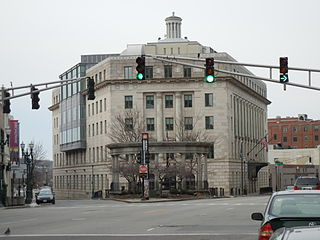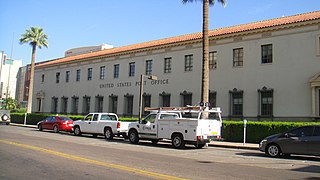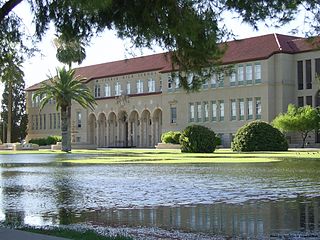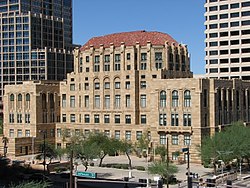
Karl Theodore Francis Bitter was an Austrian-born American sculptor best known for his architectural sculpture, memorials and residential work.

The Ventura County Courthouse, known since 1974 as Ventura City Hall, is a historic building in Ventura, California. It is located on a hill at the top of California Street, overlooking the city's downtown district with views of the Santa Barbara Channel and Channel Islands. It was the first building in the City of Ventura to be listed on the National Register of Historic Places and has also received historic designations at the state, county and city levels.
The McLean County Courthouse and Square is located in downtown Bloomington, Illinois. The site is on the National Register of Historic Places and encompasses the old McLean County Courthouse and the courthouse-facing sides of three downtown blocks. All 4 floors of the building are now occupied by the McLean County Museum of History for exhibits, collections storage, and offices. The historic buildings at the other side of the square were destroyed by fire in the 1980s. The Square is bordered by four Bloomington streets: Main Street, Center Street, Jefferson Street and Washington Street. The site was home to three previous courthouses before the current one was completed in 1903. The first courthouse at the site was built in 1831, and the second in 1836. The third was built in 1868, but suffered major damage from fire on June 19, 1900.

The Sioux City Municipal Auditorium, known as the Long Lines Family Recreation Center or Long Lines Auditorium for sponsorship reasons, is a multi-purpose facility in Sioux City, Iowa. The fifth in a line of major indoor venues built in Sioux City, it was designed by Knute E. Westerlind in 1938 and finally completed after many delays in 1950. In the building's original form, it was an arena that seated up to 3,500 people. In 2003, the building was replaced by the Tyson Events Center, built around the northeast corner of the Municipal Auditorium. The building was then converted to its current use as a recreation center while preserving the exterior building. The converted arena was originally named Long Lines Family Recreation Center, though in 2023 the building added the Long Lines Auditorium signing to the southeast entrance and inside the auditorium. The auditorium is referred to as either name.
The Arizona State Fairgrounds is a permanent fairgrounds on McDowell Road, Encanto Village, within the city of Phoenix, Arizona, United States. It is currently used yearly to host the Arizona State Fair and the Maricopa County Fair, as well as for other events.

The Yolo County Courthouse was a courthouse for the Superior Court of California in Yolo County in Woodland, California until 2015. The original building was erected in 1864, and was used for 37 years until condemned in 1911. The edifice, built in the same location in 1917, was listed on the National Register of Historic Places in 1987, and is also a contributing property in the Downtown Woodland Historic District.

The current Graham County Courthouse is a courthouse located at 800 W. Main St. in Safford, Arizona that is listed on the National Register of Historic Places. It is a two-story red brick building above a concrete foundation that includes a raised basement. The main part of the east-facing building is 83 feet (25 m) by 62 feet (19 m), and there is a one-story 17 feet (5.2 m) by 49 feet (15 m) north wing made of brick, and a small ell in the back.

The Spring Street Courthouse, formerly the United States Court House in Downtown Los Angeles, is a Moderne style building that originally served as both a post office and a courthouse. The building was designed by Gilbert Stanley Underwood and Louis A. Simon, and construction was completed in 1940. It formerly housed federal courts but is now used by Los Angeles Superior Court.

The Tomochichi Federal Building and United States Court House is a court house of the United States District Court for the Southern District of Georgia located in Savannah, Georgia. It was built between 1894 and 1899, and substantially enlarged in 1932. The building was listed in the National Register of Historic Places in 1974 as Federal Building and U.S. Court House, and was renamed in honor of the Creek Indian leader Tomochichi in 2005.

The Harold D. Donohue Federal Building and United States Courthouse, formerly known as the U.S. Post Office and Courthouse, is a courthouse of the United States District Court for the District of Massachusetts located in Worcester, Massachusetts.

The U.S. Custom house is a historic custom house in Portland in Multnomah County, Oregon. It was constructed to house offices of the United States Custom Service. It was built in 1898–1901 and is listed on the U.S. National Register of Historic Places. It is slated to become the second Portland location of Industrious, a coworking space provider, in Spring 2022.

The Fairfield County Courthouse, also known as the Court of Common Pleas, is located at 172 Golden Hill Street in downtown Bridgeport, Connecticut. It is also known as Geographical Area (GA) Courthouse No. 2 at Bridgeport. It is a Richardsonian Romanesque brick building built in 1888. It was listed on the National Register of Historic Places in 1982. It still functions as a courthouse where all but the most serious criminal cases are heard.

The U.S. Post Office at 522 North Central Avenue at 1st Avenue and West Fillmore Street in Phoenix, Arizona, also known as the Federal Building-U.S. Post Office, is a building of the United States federal government that was built in 1932-1936 and designed by Lescher and Mahoney in the Spanish Colonial Revival style. It was added to the National Register of Historic Places in 1983. It is currently part of Arizona State University's Downtown Phoenix Campus, where it houses student organizations, counseling services, administrative offices and the ASU Police Department. A USPS location is situated on the first floor of the old post office.

Lescher & Mahoney was an American architectural firm from Phoenix, Arizona.

The Richard Sheppard Arnold United States Post Office and Courthouse is a courthouse of the United States District Court for the Eastern District of Arkansas in Little Rock, Arkansas. Completed in 1932, in 2003 it was renamed for Court of Appeals judge Richard S. Arnold. It is located at 500 West Capitol Avenue. It was listed on the National Register of Historic Places in 1999 as Little Rock U.S. Post Office and Courthouse.

The Second Pinal County Courthouse, built in 1891, is an historic three-story redbrick courthouse located at Pinal and 12th streets in Florence, Pinal County, Arizona, United States. Designed by prominent Arizona architect James M. Creighton in the Late Victorian Revival style of architecture, it is Pinal County's second courthouse. It is topped by an ornate clock tower, but due to a lack of funds, the clockworks was never installed. Instead a clock was painted on it with the hands set at 11:44. Replaced in 1961 by another courthouse, it fell into disrepair and it was closed in 2005. In 2007 it was declared to be one of the most endangered historic buildings in Arizona. In January 2011, the county supervisors approved a plan to renovate the building and restore it to its former glory so that it could be used by the supervisors and other county entities. On August 2, 1978, it was added to the National Register of Historic Places.

Kemper Goodwin was a noted architect from Tempe, Arizona. He specialized in educational buildings. Some of his buildings are listed on the National Register of Historic Places in Arizona.

Edward Fairfax Neild Sr., was an American architect originally from Shreveport, Louisiana. He designed the Harry S. Truman Presidential Library and Museum in Independence, Missouri. He was selected for the task by U.S. President Harry Truman.

Edward Leighton Varney Jr. (1914–1998) was an American Modernist architect working in Phoenix, Arizona from 1937 until his retirement in 1985. He designed the Hotel Valley Ho in Scottsdale, and Sun Devil Stadium at Arizona State University. In 1941, he began his career, which would extend to his retirement in 1985. His firm would continue designing buildings into the 1990s.
The Superior Court of California, County of Sonoma, also known as the Sonoma County Superior Court or Sonoma Superior Court, is the California superior court with jurisdiction over Sonoma County.

























